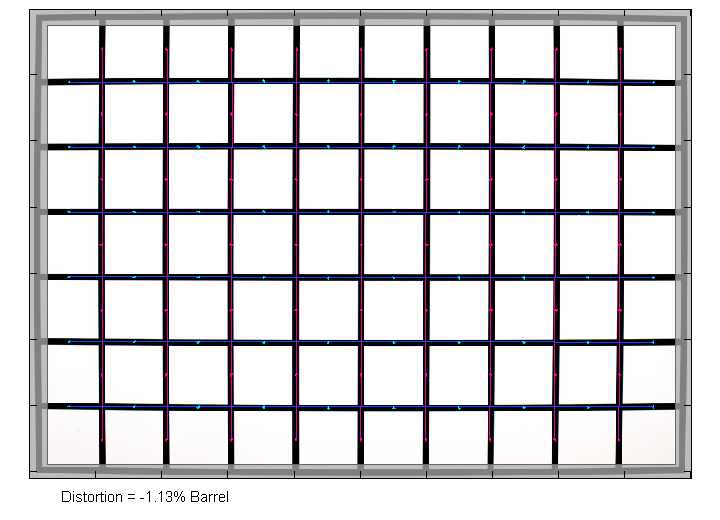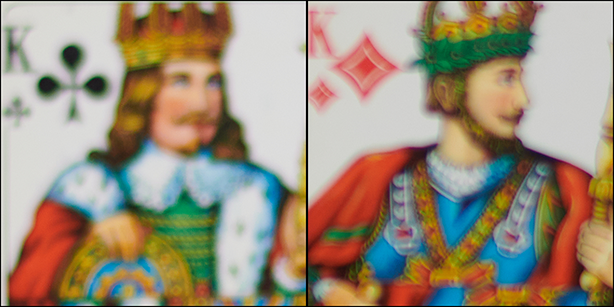|
Page 2 of 3

Distortion
The lens shows moderate barrel distortion at around 1.1%. This is more than you'd expect from a fix focal lens. However, this is actually a typical amount of distortion for fast standard primes and unless you shoot subjects with straight lines near the image borders it's usually not field-relevant.

Vignetting
Typical for most fast primes, the Nikkor shows some visible vignetting wide open with a light falloff towards the corners of just above 2.3 EV. As usual, stopping down reduces the corner darkening considerably. From f/2.8 onwards it's no longer an issue except for really critical subjects.
Please note that the vignetting results are not directly comparable with numbers in our earlier FX reviews based on the Nikon D3x. The JPG engine of the Nikon D3x featured a rather flat
gradation curve, thus had a moderate contrast characteristic, resulting in comparatively low vignetting figures - the
corresponding figures of other Nikon (and other brands) bodies are considerably higher due to the more
aggressive default contrast setting.

MTF (resolution)
The center and near center resolution is very good wide open already (but lacks some contrast here) and reaches excellent values at f/2.8.
The border sharpness is good wide open, but increases to very good values stopped down to f/2.2 and beyond.
In the image corners, the lens struggles a bit on the high-resolution sensor of the D850. Wide open, the resolution is just fair here. The lens needs to be stopped down to f/2.8 to reach good performance and further to f/4 to achieve very good resolution in the corners.
The lens showed some focus shift when stopping down (residual spherical aberration).
Please note that the MTF results are not directly comparable across the different systems!
Below is a simplified summary of the formal findings. The chart shows line widths
per picture height (LW/PH) which can be taken as a measure for sharpness.
If you want to know more about the MTF50 figures you may check out the corresponding
Imatest Explanations

Chromatic Aberrations (CAs)
Chromatic aberrations (color shadows at harsh contrast transitions) are moderate and in the range of roughly 1.4 to 1.6 pixels, achieving the lowest values wide open and slowly increasing with smaller apertures. This is a good result in the full format scope and not an issue in the field for most subjects. In addition, CAs can easily be corrected in software or by the camera itself (if you shoot JPGs).

Bokeh
One of the primary usage scenarios for a large aperture lens is to separate the main subject from the background. In such an image the quality of the bokeh (out-of-focus blur) is of major importance.
Background highlights are evenly filled, but show a small amount of outlining wide open, a little less so when stopped down, however. In addition, there are visible traces of bokeh fringing around highlights (see the next section)
 Background highlights are not perfectly circular wide open towards the borders due to mechnical vignetting. Stopped down, the shape of the aperture shapes, which are only slightly rounded, becomes visible at f/2.8 and creates polygons instead of circles from f/4 onwards.
The general out-of-focus rendition is very smooth in the image background (shown to the left below), but quite a bit more nervous in the foreground (to the right below).
Background highlights are not perfectly circular wide open towards the borders due to mechnical vignetting. Stopped down, the shape of the aperture shapes, which are only slightly rounded, becomes visible at f/2.8 and creates polygons instead of circles from f/4 onwards.
The general out-of-focus rendition is very smooth in the image background (shown to the left below), but quite a bit more nervous in the foreground (to the right below).

Bokeh Fringing / LoCA
Bokeh fringing (non-coinciding focal planes of the various colors, also referred to as longitudinal chromatic aberration, or LoCA for short) is an axial color fringing effect and a common issue with relatively fast glass. As you can notice below the halos have different colors - magenta (red + blue) in front of the focus point and green beyond.
Typical for most fast primes, the Nikkor shows noticeable bokeh fringing at large aperture settings, which can of course be reduced by stopping down.
In addition, these shots also show the focus shift when stopping down that was mentioned in the MTF section, as well as the reduced contrast wide open. The latter issue is emphasized here due to the close focus distance.
|